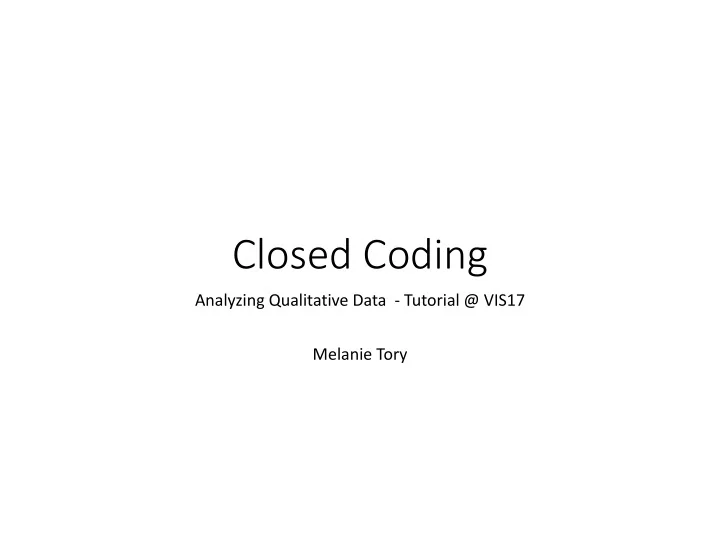

Closed Coding Analyzing Qualitative Data ‐ Tutorial @ VIS17 Melanie Tory
A code in qualitative inquiry is most often a word or short phrase that symbolically assigns a summative, salient, essence capturing, and/or evocative attribute for a portion of language‐based or visual data [Saldaña, J. (2013). The coding manual for qualitative researchers . Los Angeles: SAGE Publications.]
What is closed coding? • Identifying and marking interesting items using a pre‐established coding scheme • Usually done on video, but could be transcripts, audio, etc.
When to use closed coding? • Your research question involves counting or timing events • You know a priori what the interesting events are • You cannot mark the events by automatic logging
Closed vs. Open Coding Closed Coding Open Coding • Suitable for timing or counting • Suitable for capturing and events understanding meaning in your data • Must know in advance what is • You may have only some a priori relevant to your research question idea about what is interesting • No richness • Captures rich nuance • Confirmatory research questions • Open‐ended research questions • Largely quantitative • Purely qualitative
Where do the (closed) codes come from? • Previous research or theory • May be obvious given your research questions / hypotheses • Questions or topics from your interview guide • Establish the coding scheme during the analysis: • If you already have a good idea: • View the video once or twice and agree on a set of codes • If you have no idea: • Step 1: Open coding (later) • Step 2: Closed coding: Revisit your data to apply the codes consistently throughout all your video.
[Mahyar et al., VAST 2014]
What should you code? • Depends on your research question • Typical coded items may include: • Events • Behaviors • States of the people, system, or environment • Topics mentioned in an interview Make sure you know exactly what you are coding and how you will use that information. Coding is very time consuming!
Code Types Descriptive coding • Codes are used to describe what is in the data Analytic coding • Codes are based on the analytical thinking by the researcher about why what is occurring in the data might be happening
Code Types • Point events • Single point • Duration events • Mark start and end – enables calculation of duration Coding durations is much more time consuming. Only do it if you are certain you need duration information.
Code Types Flat Coding Hierarchical Coding e.g. position of partners around a e.g. User goals: table: • Share: • Same side • Share hypothesis • Share resources • Opposite sides • Share idea • Kitty corner • Identify • Identify object • Identify person
Coding scheme • Before applying closed coding, it is critical to establish a clear coding scheme • List all the codes and their meanings • Make sure all coders understand the scheme • Code a portion together, discuss disagreements, and modify the scheme. Test your coding scheme by having another person use it. See if they understand it the same way you do.
Software Tools • Pretty much necessary for closed coding of video • Allow you to mark events via keystroke as the video plays – automatically logs the event + time • Examples: Noldus Observer, MAXQDA
Multiple coders + inter‐coder agreement • Can your coding scheme be applied consistently by different researchers? • Inter‐coder agreement measures "the extent to which the different judges tend to assign exactly the same rating to each object" (Tinsley & Weiss, 2000, p. 98); • Often expected for papers that involve closed coding (but not open coding) • 2 coders is typical • Both must code some subset of the data with the same coding scheme
What about inter‐coder agreement? • or inter‐coder reliability, or inter‐rater reliability • terms for the extent to which independent coders evaluate some data and reach the same conclusion • measures "the extent to which the different judges tend to assign exactly the same rating to each object" (Tinsley & Weiss, 2000, p. 98) ; • in computational linguistics sometimes used to train an algorithm to do as well as a human
Inter‐coder agreement measures • Cohen’s kappa – works for 2 coders, assumes nominal data • Gwet, K. L. (2014) "Handbook of Inter‐Rater Reliability (4th Edition) • Fleiss’ kappa – works for any fixed number of coders, assumes nominal data • Shrout, P. and Fleiss, J. L. (1979) "Intraclass correlation: uses in assessing rater reliability" in Psychological Bulletin . Vol. 86, No. 2, pp. 420–428 • Krippendorf’s alpha – “generalizes several specialized agreement coefficients by accepting any number of observers, being applicable to nominal, ordinal, interval, and ratio levels of measurement, being able to handle missing data, and being corrected for small sample sizes” • ( https://en.wikipedia.org/wiki/Inter‐rater_reliability ) • Krippendorff, K. (2013). Content analysis: An introduction to its methodology, 3rd Edition . Thousand Oaks, CA: Sage. pp. 221–250
Recap: Closed Coding • Useful when you need to time or count events that can only be identified by a human observer • Confirmatory research questions • No richness, unlike open coding • Advice: • Define and test your coding scheme in advance • Know your research question and code only what you need • Get help from a tool
Recommend
More recommend